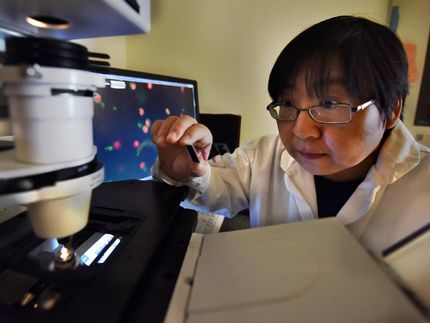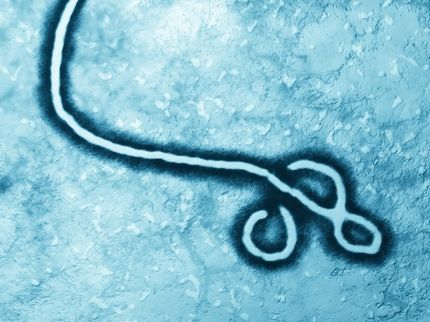Novel 'antisense' therapies protect primates from lethal Ebola and Marburg viruses
New studies show that treatments targeting specific viral genes protected monkeys infected with deadly Ebola or Marburg viruses. Furthermore, the animals were protected even when therapeutics were administered one hour after exposure — suggesting the approach holds promise for treating accidental infections in laboratory or hospital settings. The research, which appears in Nature medicine, was conducted by the U.S. Army Medical Research Institute of infectious diseases in collaboration with AVI BioPharma, a Washington-based biotechnology firm.
Working with a class of compounds known as antisense phosphorodiamidate morpholino oligomers, or PMOs, scientists first performed a series of studies with mouse and guinea pig models of Ebola to screen various chemical variations. They arrived at a therapy known as AVI-6002, which demonstrated a survival rate of better than 90 percent in animals treated either pre- or post-exposure.
Encouraged by these results, the team conducted "proof of concept" studies in which 9 rhesus monkeys were challenged with lethal Ebola virus. Treatment was initiated 30-60 minutes after exposure to the virus. In these studies, 5 of 8 monkeys survived, while the remaining animal was untreated. Further experiments, including a multiple-dose evaluation, also yielded promising results, with 3 of 5 monkeys surviving in each of the AVI-6002 treatment groups when they received a dose of 40 mg per kg of body weight.
According to first author Travis K. Warren of USAMRIID, antisense drugs are useful against viral diseases because they are designed to enter cells and eliminate viruses by preventing their replication. The drugs act by blocking critical viral genetic sequences, essentially giving the infected host time to mount an immune response and clear the virus.
The USAMRIID team next turned its attention to Marburg virus, again screening various compounds in mice and guinea pigs to select a candidate for further testing. They settled upon AVI-6003, a drug that consistently conferred a high degree of efficacy (better than 90 percent survival) in both models.
Investigators conducted two pilot studies in cynomolgus monkeys to assess the efficacy of AVI-6003 against lethal challenge with Marburg virus. As with the Ebola studies, treatments were initiated 30-60 minutes after infection. All 13 animals receiving AVI-6003 survived. Additional research provided important information about the optimal therapeutic dose range of the compound, with a 40 mg per kg body weight dose protecting 100 percent of the monkeys following challenge.
"This report of successful early post-exposure treatment of filovirus hemorrhagic fever is significant on its own," said Colonel John P. Skvorak, USAMRIID commander, "but the drug characteristics of these PMOs also support investigation of potentially broader therapeutic applications."
Senior author Sina Bavari said USAMRIID has been collaborating with AVI BioPharma since 2004. In February of that year, an Institute scientist working in a Biosafety Level 4 laboratory stuck her thumb with a needle while treating Ebola-infected mice with antibodies. As a precaution, USAMRIID medical experts recommended the investigator be isolated for 21 days to ensure that she had not been infected.
Coincidentally, earlier that very day, Dr. Patrick Iversen from AVI BioPharma had presented a seminar at USAMRIID concerning the efficacy of novel antisense drugs against a range of viruses. When he found out that a USAMRIID scientist had potentially been exposed to Ebola virus, the company volunteered to design and synthesize compounds against the virus to treat her if the need arose.
The team at AVI worked for four straight days to generate human-grade anti-Ebola compounds. In the meantime, their regulatory staff worked with USAMRIID physicians to gain emergency approval from the U.S. Food and Drug Administration to use the compounds if necessary. Five days after the exposure, AVI delivered the compounds to USAMRIID's medical team.
Fortunately, the scientist had escaped infection with Ebola virus, so the compounds were never used. However, USAMRIID went on to test them in animal models, and has been collaborating with AVI ever since.
According to the authors, the investigational new drug applications (IND) for AVI-6002 and AVI-6003 have been submitted to the U.S. Food and Drug Administration, and they are now open to proceed with clinical trials.
Original publication: Travis K. Warren, Kelly L. Warfield, Jay Wells, Dana L. Swenson, Kelly S. Donner, Sean A. Van Tongeren, Nicole L. Garza, Lian Dong, Dan V. Mourich, Stacy Crumley, Donald K. Nichols, Patrick L. Iversen and Sina Bavari; "Advanced antisense therapies for postexposure protection against lethal filovirus infections," Nature Medicine 2010.
Other news from the department science
Most read news
More news from our other portals
See the theme worlds for related content
Topic world Antibodies
Antibodies are specialized molecules of our immune system that can specifically recognize and neutralize pathogens or foreign substances. Antibody research in biotech and pharma has recognized this natural defense potential and is working intensively to make it therapeutically useful. From monoclonal antibodies used against cancer or autoimmune diseases to antibody-drug conjugates that specifically transport drugs to disease cells - the possibilities are enormous

Topic world Antibodies
Antibodies are specialized molecules of our immune system that can specifically recognize and neutralize pathogens or foreign substances. Antibody research in biotech and pharma has recognized this natural defense potential and is working intensively to make it therapeutically useful. From monoclonal antibodies used against cancer or autoimmune diseases to antibody-drug conjugates that specifically transport drugs to disease cells - the possibilities are enormous























































